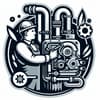Podcast
Questions and Answers
What is the underlying assumption regarding employee behavior in relation to participation?
What is the underlying assumption regarding employee behavior in relation to participation?
- Employees prefer not to participate in workplace decisions.
- Employees require strict supervision to work effectively.
- Employees perform best when kept uninformed.
- Employees behave optimally when involved in decision-making. (correct)
Which model is associated with the need for employee participation linked to job design?
Which model is associated with the need for employee participation linked to job design?
- AMO theory
- STS theory (correct)
- TQM model
- HRM model
What does the AMO theory explicitly stress?
What does the AMO theory explicitly stress?
- The autonomy of managers in decision-making.
- The need for less responsibility for employees.
- The importance of employee involvement. (correct)
- The focus on shareholders' profits.
Which approach primarily focuses on the interests of shareholders within HRM?
Which approach primarily focuses on the interests of shareholders within HRM?
What role did the 1980s TQM movement play in the context of employee participation?
What role did the 1980s TQM movement play in the context of employee participation?
Employee participation is considered most important in which organizational context?
Employee participation is considered most important in which organizational context?
Which theory emphasizes self-control and self-direction in employee involvement?
Which theory emphasizes self-control and self-direction in employee involvement?
Best (HR) practices are particularly designed to increase organizational performance based on which principle?
Best (HR) practices are particularly designed to increase organizational performance based on which principle?
What is the effect of employee participation on job satisfaction?
What is the effect of employee participation on job satisfaction?
What form of employee representation involves joint decision-making?
What form of employee representation involves joint decision-making?
Which group is mainly engaged in collective bargaining at the industry and national level?
Which group is mainly engaged in collective bargaining at the industry and national level?
What is a significant disadvantage of works councils for employees?
What is a significant disadvantage of works councils for employees?
How does financial participation affect employee motivation?
How does financial participation affect employee motivation?
What is the main function of works councils in organizations?
What is the main function of works councils in organizations?
Which of the following is NOT a benefit of employee participation in recruitment and selection?
Which of the following is NOT a benefit of employee participation in recruitment and selection?
What is a common reason for low employee participation in works council elections?
What is a common reason for low employee participation in works council elections?
Which approach emphasizes collaboration among government, employers, and trade unions?
Which approach emphasizes collaboration among government, employers, and trade unions?
In which context is employee participation most likely to occur?
In which context is employee participation most likely to occur?
Which of the following represents a main trade-off in employment relations?
Which of the following represents a main trade-off in employment relations?
What type of employee participation allows for a two-way interaction between management and employees?
What type of employee participation allows for a two-way interaction between management and employees?
What is an example of indirect representative participation?
What is an example of indirect representative participation?
How can employee representatives impact organizational changes?
How can employee representatives impact organizational changes?
What is a potential negative consequence of the 'Mum effect' in organizational communication?
What is a potential negative consequence of the 'Mum effect' in organizational communication?
Which model emphasizes the importance of treating employees as significant resources?
Which model emphasizes the importance of treating employees as significant resources?
How does effective employee participation likely influence organizational commitment?
How does effective employee participation likely influence organizational commitment?
What does defensive silence among employees indicate about their workplace environment?
What does defensive silence among employees indicate about their workplace environment?
Which HRM practice is most associated with creating a participative culture that enhances performance?
Which HRM practice is most associated with creating a participative culture that enhances performance?
Flashcards are hidden until you start studying
Study Notes
Employee Participation
- A system that allows workers to influence their work, work conditions, and work results
- Direct participation: exerting influence on one's own work
- Indirect representative participation: exerting influence through collective bargaining or representation in decision-making bodies
- Financial participation: influencing the results of their work through sharing in profits or ownership
- Underlying assumption: Employees perform best when involved in decisions, and given autonomy and responsibility
- Historical context: Employee participation gained prominence in the 1960s, driven by the HRM movement and theories like McGregor's Theory Y (self-control and self-direction) and the STS theory (emphasizing employee participation linked to job design, autonomy, and teamwork)
- TQM and HPWS models: Employee participation was central to achieving added value through people in the 1980s
- AMO theory: Emphasizes the importance of opportunity for participation (e.g., employee involvement, autonomy, and teamwork)
- Best HR practices: People management strategies aimed at boosting organizational performance, often based on the idea that what's good for employees is good for employers
- Unitarist HRM approach: Focuses on shareholder interests and the shared goals of employers and employees. Prevalent in Anglo-American contexts
- Pluralist HRM approach: Considers the diverse interests of organizational stakeholders, acknowledging potential conflicts. Central to European contexts
- Industrial relations: Emphasizes institutionalized aspects of the employment relationship, including trade unions, collective bargaining agreements, labor legislation, and power dynamics between employers and employees
Employee Participation at the Individual Level
- Degree of participation can vary based on employee characteristics
- Highly educated employees tend to seek more involvement
- Participation increases commitment, job satisfaction, morale, turnover, and productivity
- Contributes to building a competitive advantage
Escalator of Participation
- Information sharing: One-way (top-down) communication
- Communication: Interactive information sharing
- Consultation: Two-way interaction between management and employees
- Codetermination: Joint decision-making
- (Self) Control: Employees have significant autonomy and control over their work
Employee Participation at the Organizational Level
- Works councils: Institutionalized employee representation within organizations
- Engaged in issues affecting the employment relationship, including working conditions, organizational changes, HR policies, and major organizational changes
- In some countries, they are legally mandated
- Advantages: Provides infrastructure for addressing important issues, represents employee interests, and can foster a positive social atmosphere
- Disadvantages: Low employee participation in elections, poor representation, and potential for manipulation
Trade Unions
- Institutionalized employee representation at organizational, industry, and national levels
- Engaged in collective bargaining agreements, relationships with other stakeholders (employers and governments)
- Degree of unionization: Percentage of employees who are trade union members
- Role: Improving worker conditions, collective bargaining, representing worker interests, monitoring changes
- Outcomes: Employee protection, social pacts (on youth employment, training), improved working conditions, and improved benefits
Employee Participation at Different Levels
- Employee participation is likely to occur at multiple levels and in various forms
- Institutionalized HR Practices: Determined by legislation or collective bargaining agreements
- Best HR Practices: People management activities implemented by organizations to boost performance
Financial Participation
- Involves employee participation in organizational ownership and profits
- Assumption: Employees are more motivated when they have ownership
- Benefits: Employees feel taken seriously and are accountable for recruitment and selection decisions
Direct Participation
- Examples: Consultation (individual or through surveys), delegation, semi-autonomous teamwork, quality circles, socio-technical systems
Indirect Representative Participation
- Examples: Participation in organizational-level decision-making, codetermination (working conditions, labor terms), works councils, joint management committees, union committees, collective bargaining
Neo-Corporatist Approach
- Macro-level coordination between government, employers, and trade unions
- Policymaking through collaborative efforts
- Centralized collective bargaining and wage-setting
- Representative participation at the company level to shape employment relations
- Trade-offs between collective agreements and wage/labor costs, security and flexibility, long-term sustainability and short-term profits
Industrial Democracy Perspective
- Joint action of management and worker representatives to determine company policies affecting workers' welfare
- Addresses power imbalances between management and employees
- Counterbalancing power representing employee interests
- Emphasizes employee emancipation and involvement
Economic Democracy Perspective
- Shifts decision-making power from corporate managers and shareholders to a broader group of stakeholders (workers, customers, and the public)
- Emphasizes sharing surplus and labor control
- Examples: Profit sharing, employee share ownership, labor management firms, cooperatives
- "Labor should hire capital and not the other way around."
Employee Participation: A Win-Win Approach
-
Employee participation is crucial for achieving a "win-win" dynamic, shifting from a zero-sum power balance (no involvement) to a mutually beneficial strategy.
-
Employee involvement fosters commitment by tapping into their tacit knowledge and expertise, enhancing decision-making quality.
-
Effective communication is key during stressful economic times, as the "Mum effect" and "defensive silence" can distort information flow upwards.
Models of Employee Participation
-
Human Relations Model: Focuses on meeting employee social needs, leading to improved morale, satisfaction, lower resistance to change, increased compliance with authority, and higher productivity.
-
Human Resource Model: Values employees as valuable resources, emphasizing their participation in decision-making and control, resulting in increased satisfaction, morale, and overall performance.
-
Ownership Model: Views employees as co-owners, empowering them to impact decision-making and control processes, promoting internal and psychological ownership, ultimately driving higher performance.
-
High-Performance Ownership Work System: Combines effective Human Resource Management (HRM) practices, such as participation in decision-making, information sharing, and employee development, with proactive ownership culture fostering commitment, collaboration, and psychological ownership, leading to enhanced performance.
Studying That Suits You
Use AI to generate personalized quizzes and flashcards to suit your learning preferences.





